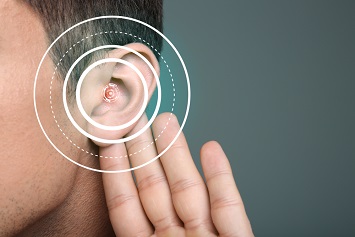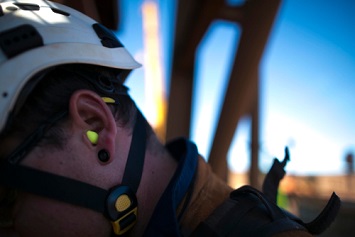Are your employees at risk for noise-induced hearing loss due to high levels of noise in the workplace? You need to monitor noise levels to be sure.
When workers’ noise exposure is at or above 85 decibels averaged over 8 working hours, or an 8-hour time-weighted average (TWA), the Occupational Safety and Health Administration (OSHA) requires employers to establish and maintain a hearing conservation program. Requirements of the OSHA standard for occupational noise exposure (29 CFR 1910.95) include noise monitoring, baseline and annual audiometric testing, hearing protection, training, and recordkeeping. Employers must maintain records of employee audiometric testing and workplace noise sampling along with the written hearing conservation program.
A hearing conservation program serves a number of purposes: providing workers with the knowledge through information and training, along with hearing protection devices necessary to safeguard themselves; attempting to prevent initial occupational hearing loss; and preserving and protecting remaining hearing in those who have suffered initial hearing loss.
During inspections, OSHA compliance safety and health officers (CSHOs) will sample noise levels and ask to see the written hearing conservation program, along with logs of noise monitoring and audiometric testing. If CSHOs find high occupational noise levels, they will check for compliance with all the provisions of the noise standard.
For example, OSHA cited a Mount Vernon, Ohio, concrete production plant for 20 safety and health violations, including the lack of a hearing conservation program, and proposed $158,555 in penalties. Agency inspectors determined that noise levels in the plant were above the permissible exposure limit (PEL) and that the company failed to monitor, train, test, and provide medical surveillance for employees exposed to noise. However, OSHA also found that the company’s employees were exposed to electrical and silica hazards, and the company had violated the lockout/tagout and respiratory protection standards.
NIOSH Research
The National Institute for Occupational Safety and Health (NIOSH) has recognized the potential for smartphone noise measurement apps to alert workers, supervisors, and occupational safety and health managers to hazardous levels of occupational noise.
Hearing loss and occupational noise exposures are among the most popular topics on NIOSH’s Science Blog. Popular blog posts include “So How Accurate Are These Smartphone Sound Measurement Apps?” and “Understanding Noise Exposure Limits: Occupational vs. General Environmental Noise.”
NIOSH researchers evaluated a number of mobile apps using both built-in smartphone microphones and calibrated, external microphones. Smartphones’ built-in microphones produced huge variations in accuracy when used with various noise measurement apps.
NIOSH researchers found that use of calibrated, external microphones greatly improved the accuracy and precision of smartphone sound measurements and removed much of the variability and limitations seen in built-in smartphone microphones.
NIOSH hearing loss researchers then collaborated with app developer EA LAB to create a sound-level meter app to measure and characterize occupational noise exposure similar to professional instruments. The institute’s collaboration with ER LAB led to the development of the NIOSH Sound Level Meter (NIOSH SLM) app for iOS devices, which is available for download from the Apple® app store.
Using an external microphone with an iPhone, the app met the American National Standards Institute’s (ANSI) standard for sound-level meters. NIOSH summarized its research and development of the app in the Science Blog post “New NIOSH Sound Level Meter App.”
The effects of general environmental noise concern researchers, as well as employers. The OSHA PEL and NIOSH-recommended exposure limit (REL) for occupational noise (85 dbA) do not account for noise outside the workplace like attending music concerts, movies, or sporting events; hunting; listening to music with ear buds; performing music; or using power tools. All may increase a worker’s overall risk for hearing loss.
Like employers, NIOSH researchers have become increasingly concerned about cumulative exposures, whether they’re to chemicals or nonoccupational noise or from working for multiple employers.
Ototoxicants, Chemicals that Cause Hearing Loss
Chemical exposures can also lead to hearing loss. Occupational health researchers concluded that exposure to certain chemicals called ototoxicants may cause hearing loss or balance problems regardless of noise exposure. However, the effects of some chemicals can be compounded by both noise exposure and smoking tobacco. Researchers found that exposure to organic solvents, along with exposure to loud noise on the job and smoking, increased a worker’s risk of hearing loss by 15%–20%.
Ototoxicants include pharmaceuticals like certain analgesics, antibiotics, and antineoplastic medications used in cancer treatment. Workplace metals, nitriles, and solvents, as well as certain asphyxiants, can contribute to hearing loss. Ototoxicity hazards show up in a range of manufacturing occupations in the chemical, electrical equipment, and boat and ship building industries.
NIOSH and OSHA summarized the research and included information about control measures and personal protective equipment (PPE) in the Safety and Health Information Bulletin “Preventing Hearing Loss Caused by Chemical (Ototoxicity) and Noise Exposure” (SHIB-03-08-2018).
Prevention begins with including information about ototoxicity on safety data sheets (SDSs). Hazard controls begin with eliminating ototoxicants from the workplace and extend to engineering controls like isolation and enclosures to control exposure to ototoxicants and noise, as well as ventilation, to reduce the risk of adverse health effects. Administrative controls may include eliminating unnecessary tasks that cause noise or ototoxicant exposure or operating noisy equipment when workers are not nearby. PPE for ototoxicity hazards include respirators and chemical-protective aprons, arm sleeves, gloves, and other clothing.
NIOSH recognized a knowledge gap when it comes to mixed noise and ototoxicant exposures in its National Occupational Research Agenda for Hearing Loss Prevention. The institute determined that further research is needed to establish recommended exposure limits for mixed exposures.
Other research priorities in hearing loss prevention include hearing protector fit testing, using appropriate age correction for audiometric data, demonstrating the “business case” for hearing loss prevention, and developing early detection of noise-induced hearing loss.
Construction Hazard
While the “Focus Four” (or “Fatal Four’”) construction safety hazards are caught-in/caught-between, electrocution, fall, and struck-by hazards, the American Industrial Hygiene Association (AIHA) identified four construction health hazards that include noise, as well as air contaminants, heat, and manual materials handling. The AIHA reminded employers that high noise levels can cause hearing loss and tinnitus (ringing in the ears) and remarked that almost three-quarters of construction workers may be exposed to noise levels above NIOSH’s recommended exposure level.
Noise is present in nearly every construction task or trade, according to the AIHA, including carpentry, drill and grinder operation, heavy equipment operations, highway and road construction, iron work, landscaping, power tool operation, pneumatic tool operation, residential construction, sand or abrasive blasting, sheet metal work, welding, and work near diesel- or gasoline-powered generators. The AIHA recommended that employers and supervisors identify and plan controls for sources of noise. It also advised employers and supervisors to train, track, and test employees to prevent hearing loss.
The AIHA suggested substituting less noisy tools or using sound-absorbing materials
to limit noise at the source because PPE like earmuffs or earplugs only protects the wearer. The group also recommended that employers provide hearing awareness training that would cover nonoccupational exposures like attending auto races or music concerts, motorcycle riding, and shooting firearms.
Construction sites have an average noise level of between 80 and 90 decibels, according to the American Society of Safety Professionals (ASSP). The group maintains an industry consensus standard for prevention hearing loss in construction and demolition (ANSI/ASSP A10.46). Like OSHA’s regulations and NIOSH’s recommendation, ASSP’s advice includes worker training, the elimination of hazards, and the use of hearing protection.
Noise Exposure in Service Industries
Noise-induced hearing loss is most often associated with construction and manufacturing, and mining occupations and those sectors are recognized as having high percentages of workers exposed to hazardous noise and who are at higher risk of hearing loss. However, a large number of workers in the services industry sector, the largest employment sector in U.S. industry, may also have an elevated risk of hearing loss. NIOSH researchers recently looked at hearing loss in workers across a wide variety of service industries.
Workers in the administration of urban planning and community and rural development had the highest prevalence of hearing loss (50%) and workers in solid waste combustors and incinerators had the highest risk of any subsector—more than double. Even subsectors often considered “low risk,” like professional and technical services and schools, had a higher-than-expected prevalence or risk of hearing loss. Fields like custom computer programming and elementary and secondary schools had prevalences of 35% and 26%, respectively.
Medication to Prevent Hearing Loss?
Employers may one day have an additional weapon in the hearing conservation arsenal: drugs. The research remains in its early stages, but researchers at NIOSH and elsewhere are exploring the potential for “otoprotective” pharmaceuticals to protect ears from noise damage.
Occupational health researchers recently reviewed three broad areas of current research and the potential for research and development of pharmaceuticals for hearing loss prevention:
- The animal models that have been used so far in preclinical drug development paradigms. Animals already studied include chinchillas, guinea pigs, mice, and rats.
- Real-world noise hazards and patterns of human injury.
- An examination of various noise sources that could suggest the most appropriate ways to proceed with clinical testing and development of drugs.
For now, noise-induced hearing loss from occupational noise exposure remains a common workplace hazard. Researchers at NIOSH and elsewhere continue to look into cumulative risks of occupational and nonoccupational exposures, as well as the mixed hazards of noise and ototoxicant exposures.
NIOSH, along with the National Hearing Conservation Association (NHCA) and Council for Accreditation in Occupational Hearing Conservation (CAOHC), recently awarded Boeing’s Mesa, Arizona, facility the 2021 Safe-in-Sound Excellence in Hearing Loss Prevention Award. Boeing Mesa developed a noise suppression kit, or “hush kit,” to reduce noise levels generated when workers need to test AH-64E Apache helicopters.
You need to measure noise levels to understand what your employees’ noise exposures are. If workplace noise levels are high, you need to establish a hearing conservation program that conforms to the requirements of OSHA occupational noise exposure standard. You also need to rely upon the hierarchy of controls—elimination, substitution, engineering controls, administrative controls, and PPE—to control noise exposures. Controls available to you might include quieter equipment, barriers to prevent noise from reaching workers, and scheduling work so workers can avoid too much noise.


